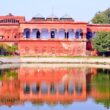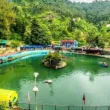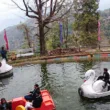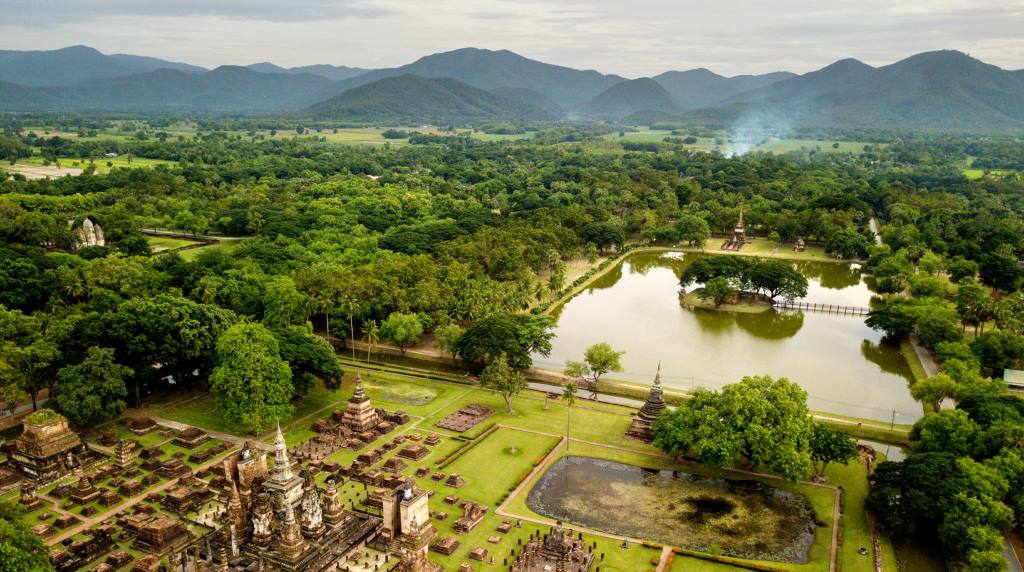Many of the best things to do in Sukhothai can be enjoyed self-guided in a couple of days; Just grab a bicycle and go! Located about halfway between Bangkok and Chiang Mai, Thailand’s ancient capital from the 13th century achieved UNESCO World Heritage status in 1991.
Unlike Ayutthaya, one of Thailand’s ancient capitals, Sukhothai has a more compact feel and is often less crowded. The distance from Bangkok deters some travelers who choose to take the short two-hour trip to explore the ruins of Ayutthaya, although both cities are worth visiting.
Sukhothai is older than Ayutthaya, which makes the remaining ruins all the more impressive. The Thai system of writing was developed in the Sukhothai Kingdom in 1283. The modern alphabet still looks like the original stone inscriptions found on the ruins around the park!
12 Best Things to Do in Sukhothai, Thailand
- Visit the Ramkhamhaeng National Museum
Yes, it’s not easy spending time indoors under fluorescent lighting when so many archaeological treatments await at the Sukhothai Historical Park, but learning a little bit of Sukhothai’s history will greatly enhance your experience there. Without the slightest understanding, all the Buddha statues and restored sites will be blurred into a huge archaeological mess.
You should reach the museum immediately after reaching Sukhothai. If time is short, perhaps consider exploring the ruins that fill the historic park in the morning (the best time to do so, anyway) then hide from the heat of the day at the museum. The time spent in the museum will help you understand what you saw that morning. After closing in the afternoon, go back to exploring the temples and pick a nice spot for sunset.
Ramkhamhe National Museum remains open till 4 pm. The entrance fee is 150 baht and you must leave your backpack in the locker.
- Rent a Bicycle and Begin Exploring
Although you can certainly explore historic areas on foot, having a bicycle greatly expands your range. Many guesthouses will lend bicycles to guests for free. If not, rent one from the shops near the main entrance to Sukhothai Historical Park.
The bike may have seen better days, but the fare is cheap (40-50 baht per day). A bicycle will allow you to see fringe sites without the extra responsibility that comes with driving and parking a scooter.
If you haven’t ridden a bicycle in decades, or feel like being lazy in the heat, hop on the electric tram that spins through the park. Guided tours are only 60 baht.
- Visit the Sangkhalok Museum
If you have thoroughly enjoyed the Ramkhanhe National Museum, or perhaps need a place to go inside during the rainy season, Sanghalok Museum is another good option.
Like the Ramkhamhen National Museum, a visit to the Sangkhlok Museum will expand your understanding of the area’s many ruins. The museum is home to a large collection of ancient ceramics – a must for anyone interested in pottery. Admission is about 100 baht.
- Explore Wat Mahathat
Considered the most important temple in Sukhothai, the “Temple of the Great Relics” houses the relics of the Buddha. Wat Manhattan was built between 1292 and 1347; It served as the primary temple for the Sukhothai kingdom.
Wat Mahathat is the largest and most visited of all the temple ruins in Sukhothai. Arrive either early or late in the day – doing so will help you avoid most excursion groups flocking to the temple. You can even catch a break when they go for lunch.
Note: The name “Wat Mahathat” is used for several temples throughout Thailand, including a popular temple in Ayutthaya.
- Experience the Magic of Wat Si Chum
Wat Si Chum is one of those destinations that brings out the inner Indiana Jones, much like some of the vine-tangled temples at Angkor Wat, Cambodia. Second, only to Wat Mahat in popularity, Wat Si Chum is very photogenic.
The real attraction of Wat Si Chum is to see the 50-foot-tall Buddha statue through an equally tall slit at the entrance. The fingers pointing down are rubbed with gold. Engraved slates along a corridor depict the life of the Buddha. These works of art are considered the oldest examples of Thai drawing.
Like Wat Mahthat, it’s essential to visit early and beat tour groups to capture the magic – and good – pictures of Wat Si Chum.
- See the Elephants at Wat Chang Lom
Chang means “elephant” in Thai, and that’s exactly what you’ll see in this beautifully restored temple. The 32 stone elephants that surround the bell-shaped stupa stand in meditation.
Wat Chang Lom is a bit out of the ordinary temple circuit. Find it behind the famous Sukhothai Hotel and once you’ve had your fill of the temple, there are plenty of dining and shopping opportunities nearby.
Note: An hour north of Sukhothai is another Wat Chang Lom. If you hired a driver, make sure they understand who you want to meet!
- See Khmer Architecture at Wat Si Sawai
Wat Si Sawai is different from the rest of the temples in Sukhothai as it was originally a Hindu temple. It is also one of the oldest temples there.
Anyone who has already visited Angkor Wat will immediately notice the distinctive Khmer-style architecture inside the moat. Several sculptures of Hindu deities have been found in the area and are now on display in the National Museum. Wat Si Sawai was converted into a Buddhist temple sometime in the 14th century.
- Watch Sunset at Wat Sa Si
Wat Sa Si is small compared to other temples around the historic park, but the tranquil setting makes up for the size. The temple is surrounded by water and makes beautiful pictures of the sunset. With some luck and good lighting, you can get pictures with reds and oranges visible in the temple lake.
The stupa at Wat Sa Si is round with a point at the top, the same style seen throughout Sri Lanka. Chedi is said to house the ashes of a former king of Sukhothai.
Remember: Temple ruins are considered sacred places and are often visited by monks. Common ways of showing respect apply in temples.
- Take a Day Trip to Si Satchanalai
Si Sachanalai Historical Park is about an hour’s drive north of Sukhothai. Founded in 1250, the ruins of the “City of the Good People” resemble a miniature Sukhothai Historical Park. You’ll find impressive temples, Buddha statues, and remnants of the city’s defenses to keep out Burmese invaders. The ruins of the temple are as impressive as the Sukhothai Historical Park.
Si Sachanalai can be easily explored on foot and is a UNESCO World Heritage Site worthy of a visit.
- Go See the Thuriang Kilns
If you’ve already explored enough temples to experience “wat burnout,” consider driving north to the remains of the Thuriang kilns. Dozens of ancient ceramic kilns were not discovered until the end of the twentieth century.
Many kilns are protected from the elements with roofs, making the site a great option for getting out of the sun or rain for a while. The roughly 15-foot-long kilns once broke porcelain bricks and pottery at the summit of the Sukhothai Empire.
Locate the Thuriang kilns a little north of Si Sachchanalai. You will need to hire a driver or rent a scooter.
- Eat in the Markets
The best way to find the pulse of any new place is to spend time in the markets. There are many in Sukhothai; Try to enjoy authentic, cheap food at the night market or the fresh morning market.
The night market in Sukhothai is busy enough to be exciting. You will usually see more Thais nibbling and socializing than tourists. Centralized seating (open) allows passengers to socialize and enjoy delicious treats.
The morning market in Sukhothai is excellent for people looking to see and sample the local vibe. Although many stalls specialize in raw materials for local homes and restaurants, there are few opportunities to pick up local fare. Have some sticky rice, which is usually eaten with fingers; Use your right hand to be polite.
Keep an eye out for fresh fruit (look for mangosteens when in season) and fried meats wrapped in banana leaves.
- Try Sukhothai Noodles
Sukhothai has its own version of the ubiquitous Ku Tie noodle soup from Southeast Asia. It can be difficult to find the Sukhothai version elsewhere.
Following a centuries-old recipe, rice noodles are marinated in a bone broth with thinly sliced pork, ground peanuts, bean sprouts, and chopped vegetables. Some improvements include lemon juice and salty nam pla (fish sauce) to tone down the mild sweetness of the broth.
Local restaurants and night markets have Sukhothai Kue tye (sounds like “kewe tee-ow”; transliteration spellings on menus vary). Noodles can be enjoyed as a soup or “dry”.
Similar Articles








